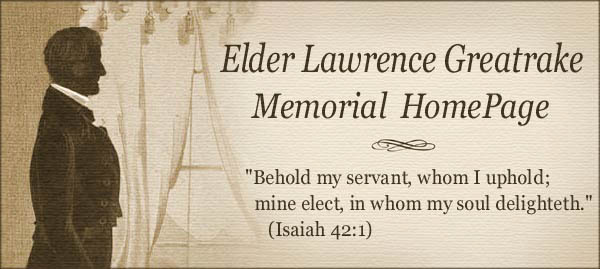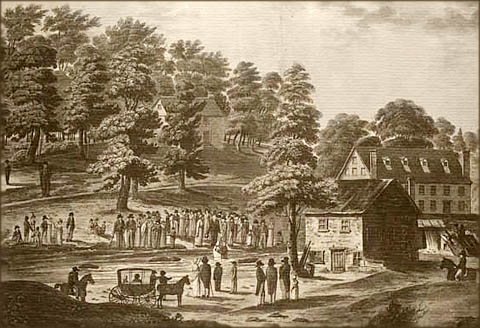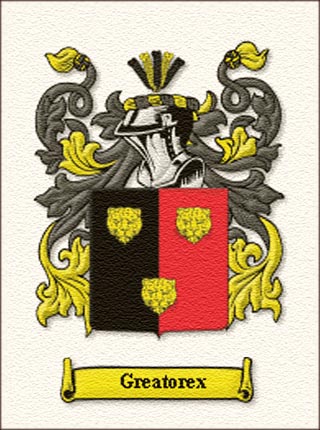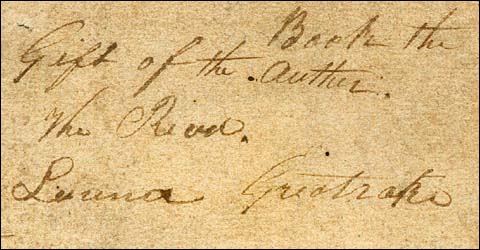SIDNEYRIGDON.COM -- Opening New Horizons in Mormon History.

The Elder Lawrence Greatrake
Memorial Home-Page
|
|
TRANSCRIBER'S COMMENTS
FILE: “Greatrake-Lawrence BIO.doc” 06-0719; rev. 06-0720; 06-0721;
-LAWRENCE GREATRAKE
(various spellings): Biographical Data (Charles) Lawrence Greatrake,
Sr. was born c.1757 in England. He and his family came to Philadelphia
from Herford around 1799, and lived on Brandywine Creek, in the Christiana
Hundred (Newcastle co.) of nearby Delaware. The name appears to be of
Dutch or Flemish origin, although some sources indicate a French ancestry,
possibly descended from Huguenot refugees who had fled to England.
Shortly after his arrival in
America, Greatrake Sr. became associated with the Second Baptist Church
of Baltimore, and was licensed to preach by that church about 1800 (ref.
Hassell below). This suggests he may have preached in England prior
to his immigration.
From around 1809 (perhaps earlier) until 1812 or ’13, the Greatrakes appear to have been in England, returning around the time the War of 1812 began. In 1815-16, Lawrence, Sr. is known to have gone to England again, this time in connection with Joshua Gilpin’s paper-making enterprise, which had its princpal mill on Brandywine Creek near Wilmington, Delaware. In this endeavor it seems evident that his motives were not entirely above board, for according to Hancock and Wilkinson,* Greatrake, who was then manager of the Gilpin mills, had been sent to England by Gilpins for the express purpose of “paying special attention to papermaking.” During this time, the Gilpins “were endeavoring by every means in their power to obtain models, drawings, and patent specifications of the Fourdrinier and Dickinson [paper-making] machines....” Moreover, when Thomas Gilpin developed an improved paper-making machine in America shortly thereafter (1817), and claimed credit for it as his own invention, Hancock and Wilkinson reveal that Gilpin was then “in possession of a detailed drawing of at least one machine and had probably received patent specifications for both English models which he had discussed with his brother and Greatrake.” Indeed, Greatrake “had once been a fellow apprentice with Dickinson in the firm of Richardson and Harrison, stationers to the East India Company,” and does not seem to have hesitated to use his friendship with the man to gain his confidence in order to obtain the secrets of his invention. * Harold B. Hancock & Norman B. Wilkinson, “The Gilpin Papermaking Machine,” Pennsylvania Magazine of History and Biography, Historical Society of Pennsylvania, LXXXI (1956): 391-405.
Lawrence Greatrake, Sr. and his wife Eliza appear to have had seven children: Eliza, George, Henry, Mary Ann, Lydia, Sarah and (Charles) Lawrence, Jr. (not necessarily in order).* By all appearances, Lawrence, Sr. died prior to 1820 (see following), and his son George seems to have taken over the management of the Gilpin mill. *Mary Ann married a Captain Roberts; Eliza was briefly married to Benjamin Franklin Peale (m.Apr.24, 1815),
the union being later annulled. Lawrence Greatrake, Jr. married Anne Marie Jaquett, probably in 1814,* and the couple had at least four children, [tentatively] girls Elizabeth M.* and one other daughter born before 1819; and boys Charles L. (c.1819, Maryland; living in IN, 1860) and George W. (1824, PA?). There were perhaps others. From at least 1819 until around 1823, Lawrence, Jr. lived in Baltimore where he was connected with (managed?) the Franklin Paper Mill.# * Ref: Biographical Review, Containing the Life Sketches of Leading Citizens of Pittsburgh and Vicinity, (Boston: Biographical Review Pub. Co., 1897), 49: Samuel F. Cole, b. Pittsburgh, June 9, 1845, son of John F. and Elizabeth M. (Greatrake) Cole. Elizabeth was the daughter of Joquett Greatrake, a Baptist minister of
French extraction [sic]. She d.1883. On February 22, 1822, Lawrence Jr.’s brother George suffered serious injury during a flood which destroyed part of the Gilpin mill. Afterwards, he developed a lung ailment, left Delaware to seek treatment in the South, and died there about 1825. It was during this years, perhaps in 1823, that Lawrence, Jr. and his family moved to Pittsburgh, possibly to seek new opportunities as a paper-maker. By this time, he may have already been a licensed minister for the Baptists, apparently having been ordained a Regular Baptist preacher either in or near Pittsburgh, in 1823 or early 1824. Rev. Greatrake then took over leadership of the much diminished First Baptist Church in that city, replacing the Rev. John Winter in that capacity. Rev. Lawrence Greatrake was briefly hired as the church's official pastor, but seems to have relinquished that office by the end of 1825. He was listed in an 1826 Pittsburgh city directory as a minister residing in that city, and remained there until at least 1827. *The record says 1834, but must be in error. #The Franklin Paper Mill was founded by Aaron Levering in 1807-08. It and an associated woollen mill were sold to Lewin Wethered in 1830. ============================== NOTES AND REFERENCES: -Parish records in England provide the following information: Laurence Greatrake / Greatrix / Greatrex / Greatorex -- wife: Eliza _____ ; children: (i) Chas. Laurence Greatrake, b. 08 May 1793; Hemel Hempstead, Hertford, England (ii) George Greatrake b. 27 Oct 1794; Hemel Hempstead, Hertford, England (iii) Henry Joseph Greatrake b. 18 Feb 1798; Hemel Hempstead, Hertford, England ------------------------------ -Ref: Cushing Biggs Hassell,
History of the Church of God from the Creation to 1885, (n.p., c.1885),
Ch.XXVII, in section on Maryland under heading “Reminiscences of some
churches in the original bounds of the Baltimore Association.”
http://www.pbministries.org “The first Baptist Church in Maryland of which we have any account is that of Chesnut Ridge, afterwards Saters, Baltimore County.... Mr. Sater came from England in 1709. The church was constituted in 1742 with fifty-seven members, and bore the name of General Baptists. “The oldest church bearing the name of Particular Baptist in the Baltimore Association was called Winter’s Run, afterwards Harford, Harford County. “It is said that about the year 1747 some of the members of Chesnut Ridge being inclined to the sentiment of the Particular Baptists, invited their ministers to preach amongst them, who continued their visits until fourteen persons had embraced their sentiments, and these were constituted into a church in 1754, by the assistance of Benjamin Griffith and Peter Vanhorn, and the church was that same year received into the Philadelphia Association. In 1772, besides the main establishment at Winter’s Run, the church consisted of three other branches; one near Chesnut Ridge, which met for worship in the house belonging to the General Baptists; the second was at Patapsco; and the third near Winchester; and there was, in all, at this time, a membership of 138. “Elder John Davis [d.1807] continued in the pastorate of the church for more than fifty years; and established the First Baltimore, Taney Town, Gunpowder and Sater’s Churches. The First Baltimore was established in 1795 with eleven members, all of whom except Elder Lewis Richards were dismissed from Harford Church. The second church of Baltimore was constituted by Elder John Healy and a few English Baptists, and their meeting-house built in 1797. This church may be called, in the Baltimore Association, the mother of preachers, as Harford was called the mother of churches. The first licensed in this church was Elder Daniel Dodge, after him was Lawrence Greatrake,* William Brinkers, Joseph Trapnell, W. Curtis, William Reck, Joseph Cone, Bartholomew T. Welch and Joseph H. Jones. *Lawrence Greatrake, Sr. appears to have arrived at Philadelphia with his family in 1799, not long after this church was established. Thus it must have been he who was licensed, as his son, Lawrence, Jr. would have been only a child at this time. Perhaps he had previously preached in England. ------------------------------ -Ref: Scott, Kenneth, compiler, British Aliens in the United States during the War of 1812, (Baltimore: Genealogical Publishing Co., 1979) 254. Year: 1812 Name: Lawrence Greatrake [Sr.] Age: 55 Place: Delaware ------------------------------ -Ref: ibidem Year: 1813 Name: Lawrence Greatrake, Jr. ; Age: 20; Place: Delaware Name: George Greatrake; Age: 18; Place: Delaware Name: Henry Greatrake; Age: 15; Place: Delaware ------------------------------ -Ref: ibidem, 384. Year 1813 Name: Lawrence Greatrake [Sr.?]; Place: Washington, District of Columbia [age not given] ------------------------------ -Ref: Philadelphia 1800-1850 Passenger & Immigration Lists Record Name: Laurence Greatrake Arrival Date: Jul 03, 1816 Port of Arrival: Philadelphia Port of Departure: London Ship Name: Ship William Carlton National Archives' Series Number: 425 Microfilm Number: 22 List Number: 124 ------------------------------ -1790 US census: Nearest matches are Greatreaux in RI and Graytracks in NY. ------------------------------ -1800 census lists: -Delaware, Newcastle, Christiana Hundred, 139 -Laurence Greatrater, head of household Males: 10-15=2 Females: 10-15=3 16-44=4 3 other free persons (not Indians)
------------------------------ -1810 census: Only listing for Greatrake or varient spelling is a family named Greatreakes residing in Providence, RI. Lawrence and his family were probably abroad in England when this census was taken.
------------------------------ -1819: Ref. Jackson, Samuel, compiler, The Baltimore Directory, corrected to June, 1819, (Baltimore: Richard J. Matchett) alphabetical. -Name: Lawrence Greatrake; Baltimore; paper merchant; Address: business: St. Paul's lane near Market street; dwelling: Camden near Hanover.
------------------------------ -1820 census lists: -DELAWARE, Newcastle, Christiana Hundred, 120 (census dated January 13, 1820) -Joshua Gilpin, head of household: Males: 2-1-0-1-1-1 Females: 1-1-4-1-0 Foreigners not naturalized=1, Persons engaged in Manufacture=1 -Eliza Greatrake, head of household: Males: 16-25=1 [Probably George, b.1794, since Henry, b.1798, seems to have Females: 10-15=1 [Sarah] 16-25=3 [Lydia, Mary Ann, Eliza] 26-44=1 [perhaps a servant?] 45+ =1 [Eliza] Free Colored Persons: 1 Female aged 0-14; 1 Female aged 16-45
Number of persons engaged in Manufacture=1 [George] -MARYLAND, Baltimore, First Election District, 336/349 (census dated January 13, 1820) -Laurence Graterick, &c. Franklin Paper Mill [apparently a collective entry]: Males: 10-15=3 [young apprentices?] 26-44=6 [journeymen? or perhaps 5 journeymen and Lawrence, Jr., aged 45+ =1 [mill foreman? or perhaps Lawrence, Sr., then aged about 64?] Females: None Free Colored Persons: 1 Male aged 45+; 1 Female aged 45+ Number of persons engaged in Manufacture=12 -Laurence Graterick, head of household: Males: 0-9=1 Females: 0-9=2 26-44=1
Free Colored Persons: 1 Male aged 0-14; 2 Females aged 0-14 -MARYLAND, Baltimore, 12th ward, 110/179 (census dated October 23, 1820) -Lawrence Graetrake, head of household Males: 0-9=1 [George, b.1818 in England? See 1880 Phila. PA census] 16-25=1 [Henry, b.1798?, appears to have gone to Ohio & Kentucky; sons 26-44=2 [Lawrence, Jr., b.1793; George W., b.1794] Females: 0-9=2 [2 daughters; Elizabeth M. and unk.] 16-26=1 [Anne Marie Jacquett Greatrake, b.1793] Free Colored Persons: 1 Female aged 0-14; 1 Female aged 14-26 Number of persons engaged in Manufacture=1
------------------------------ -Ref: Delaware Marriage Index: 1645-1899: Laurence Greatrake; Married June 1, 1834 [sic - 1814?]* County: New Castle, DE; Spouse name: Maria Jaquett. Given the information in the 1820 census, the 1834 date is certainly incorrect, but DB’s tentative correction to “1824” is questionable given the tombstone inscription of George W. Greatrake, who is thereby identified as the “Second Son of Rev. Lawrence and Ann Maria [Maria Jaquett], ___ 6, 1824 - Feb 9, 1854” (stone worn, birth month illegible). A date of 1814 would seem to be more likely given that in 1820 Lawrence and his wife (b.1793—see below) already had three children, two girls and a boy, all under age 10. The boy, who would have been George W.’s elder brother, appears to have been Charles L. Greatrake III, born in Maryland c.1819. 1860 census, PA, Allegheny, Allegheny, ward 4, lists A. Greatrake, age 67, born in Delaware; 1870 census, PA, Allegheny, Allegheny, ward 1, lists Marie Greatrake, age 77 (b.1793), born in Delaware; 1880 census, PA, Allegheny, Brushton, lists A.M. Greatrake, age 88, widow, born in Delaware (father b. in DE, mother b. in MD), living as a boarder in the family of William H. Marshall, telegrapher, age 28. Also living with the same family was Wm. H.’s brother Laurence G[reatrake?] Marshall, age 38, who worked in c--- [illegible], was unemployed for 5 months during that year, and is listed as disabled due to “rush of blood to the head.” (Perhaps the Marshalls were grandchildren?)
------------------------------ -The assertion that Lawrence
Greatrake, Sr. was already dead by 1820 is also supported in Elizabeth
Montgomery, Reminiscences of Wilmington, in Familiar Village Tales,
Ancient and New, (Philadelphia: T.K. Collins, Jr., 1851) 37-39: [37] “In an elevated and picturesque situation, on an upper part of the lawn, near the top of the hill, but surrounded by a forest grove, stands the very neat cottage of the higher order, built by Joshua Gilpin, Jr., and called Kentmere. It is beautifully situated, with an extensive view over the valley of the Brandywine and the Delaware; with gardens and walks around it tastefully arranged. This mansion is to well known [38] to be further described, where many visitors from the neighborhood and cities have been so hospitably entertained. Mr. Gilpin resided here with his family the latter part of his life; and died there in the year 1841. “In the day of prosperity, the large stone house opposite the mill was occupied by Lawrence Greatrake, who managed the concern of paper-making. Death summoned him suddenly, in the vigor of his life, to leave this extensive business and his large family. A youthful son succeeded him in the management of the establishment for years. It was a beautiful spot, and all around it was kept in the neatest order, shaded by trees, shrubbery and vines. Yet no withered leaves or broken branches marred this rich verdure on this hill. The mistress of the mansion, Mrs. [Eliza] G[reatrake], arranged all within her bounds in good taste.... There are many who remember the civilites tendered to them by this family.... [39] “...Mr. G[eorge] Greatrake, by personal exertion in the freshet of ’22,* impaired his constitution, and became the victim of a disease of the lungs, and in a few years [1825?] died at the south, whither he went to recruit his health. From his knowledge of the business, and popularity with the workmen, his death was a great loss to the establishment. But the business being changed and the estate having fallen into other hands, everything was soon on the wane; and we lament to note the decline and fall of an establishment of which this town could once boast, as unrivaled in its order and pleasant scenery, and the delightful amusement of distant friends in their walk to view the operations at the old paper-mill. “How old things have changed! The buildings are now [1851] cotton mills with additions....” *This flood (Feb. 22nd, 1822) caused severe damage to the papermill, as did a fire which occurred two or three years later. “For all their innovations, the Gilpin papermills did not prosper. The flood and fire in the 1820’s had ruined a part of the mill. Moreover, the Gilpins had sustained financial reverses, losing money in establishing cotton and woolen mills during the War of 1812, and in riding out the depression of 1819.... Beginning in 1825, the Gilpins made repeated efforts to obtain new capital and to secure a charter from the Delaware legislature. These attempts were unsuccessful until 1837....” (Harold B. Hancock & Norman B. Wilkinson, “The Gilpin Papermaking Machine,” Pennsylvania Magazine of History and Biography, Historical Society of Pennsylvania, LXXXI (1956): 405.)
------------------------------ -Ref: J. Thomas Scharf, History of Delaware 1609-1888, (Philadelphia: L.J. Richards & Co., 1888), I, 38:
www.accessible.com/amcnty/DE “Kentmere, near the Riddle Mills on the Brandywine, was the location of some of the first factories and flour-mills. Joshua and Thomas Gilpin had their paper-mills there in 1787, the first to manufacture paper by means of revolving cylinders. They had a foundry near by, at which they constructed their own machinery. The erection of these mills and the improvements to 1838 cost $350,000. In 1821 they provided Matthew Carey & Son, of Philadelphia, with paper for printing a large edition of Lavoisne’s Celebrated Atlas. Their mills soon become widely known and the new process was destined to entirely revolutionize the business of making paper in this country. The difficulties which followed were very discouraging. Others were envious of the probable success of the new invention, and obtained information of the process from some of the employees of these mills. By these means sufficient knowledge was gained to secure a patent and make similar machinery by avoiding infringement of Gilpin’s patent. By the year 1825 the improved machinery was introduced into the paper-mills at Springfield, Massachusetts, and soon thereafter into other paper-mills throughout the country, and the prestige of the invention was never properly credited to Thomas Gilpin. “The great flood of February 22, 1822, when the Brandywine rose twenty feet above its banks, took away the dam, destroyed the races and badly injured much of the machinery and some of the buildings of these mills, and in April, 1825, one of the buildings and its valuable machinery were destroyed by fire. By the freshet of 1838 still greater damage was done and the bridges immediately below were carried away. The Gilpins owned and conducted the paper-mills for half a century, when the business was discontinued and the property sold to a company that spent five hundred thousand dollars in improvements. Large quantities of bank-note paper were also made here. Thomas Gilpin resided most of the year in Philadelphia, but spent part of each summer at the mills in a pleasant cottage. On a more elevated portion, surrounded by a forest, was the house of John Gilpin. He called it Kentmere. In it he entertained his numerous friends who frequently visited him. He died here in 1841. The large stone house opposite the mill was occupied by Lawrence Greatrake, manager of the establishment. The buildings after their sale by the Gilpins were turned into cotton-mills.” ------------------------------ -Ref: Anthony F.C. Wallace,
Rockdale: The Growth of an American Village in the Early Industrial
Revolution, 217-18, 258: [217-18] “...in the 1820s, a steady stream of English and French mechanicians... came to America... in the Philadelphia area, among the best known were the... Greatrake family on the Brandywine.... Lawrence Greatrake [Sr.], technical manager for Thomas Gilipin” (in Delaware Co. near Philadephia) [258] “Franklin Peale (son
of Charles Wilson Peale) married the daughter of the Gilipins’ mechanical
expert, Thomas Greatrake. The Greatrakes were Quakers and the young
woman [Eliza] was a “Quaker Preacher* of extreme religious zeal...
the marriage was annulled....”
*The writer seems to have been misinformed. Gilpins were Quakers, not the Greatrakes. WM
------------------------------ -Ref: Robert Richardson, Memoirs
of Alexander Campbell, Volume II (1869), Chapter III, 98-99: [98] “Another individual, who made himself quite notorious about this time, was Lawrence Greatrake, a regular Baptist preacher, of a restless spirit and strong passions, who occupied himself in itinerating through the country, wherever he could obtain a hearing, either in Baptist or Pædobaptist congregations, breathing forth misrepresentation and abuse of [99] Mr. Campbell and his teachings. The bitter spirit, however, by which he was characterized, rendered his reckless assertions doubtful to thoughtful and impartial hearers, and served rather to further the Reformation by exciting their curiosity to read Mr. Campbell's writings or to hear him for themselves. As to Mr. Greatrake, he continued his itinerant labors for a considerable time, and published a scurrilous pamphlet against Mr. Campbell; but afterward, falling into disgrace, became an apostate, and finally, in passing through a piece of woods on his way to a place of shelter, was suddenly crushed to death by a falling tree.”
------------------------------ -Item: Cannot locate Lawrence
Greatrake in 1830 census. The following derives from an
Ancestry.com
message board: Re: Ky. Baptists; Author: Arva McCabe Date: 28 Jan 2001 In Reply to: Lewis Craig by: Gayle Carson I am trying to connect Lawrence Greatrake, a "regular Baptist" minister who wrote several pamphlets against Alexander Campbell. Does he appear in any of the Kentucky Baptist books? Any help you could give me would be apprecitaed. I live in Miami and do not have access to the Baptist books you mentioned. I am trying to connect him to Henry Fink of Fayette and Scott Co. Ky (1790-1810)whose son later lived in Delaware at the site of the Gilpin papermill. Lawrence Greatrake, Sr. was a papermaker there. Thanks
------------------------------ Re: Rev. Laurence Greatrake Author: Arva McCabe Date: 18 Mar 2001 Rev. Laurence Greatrake died in Paris, Tennessee in 1830. He was a well known Regular Baptist itinerant minister who wrote many books against Alexander Campbell c 1812-30. If anyone can find information on him I would be very grateful. The story goes is that he was in a forest when lightning struck a tree and it fell on him and killed him. I am not related to him but am writing a biography of a man who may be.
------------------------------ Lawrence Greatrake: Bibliography 01. Letters To Alexander Campbell, by A Regular Baptist, 30 p.; 22 cm. (9 in.) Pittsburgh: Eichbaum & Johnston, Aug. 1824 (Princeton Theological Seminary Library) 02. "New Publication," Pittsburgh Recorder, Aug. 31, 1824 03. "Notice," Pittsburgh Recorder, Oct. 5, 1824 04. "New Publication," Western Luminary, Oct. 6, 1824 05. "To the Public," Pittsburgh Recorder, Nov. 2, 1824 06. Letters To Alexander Campbell, by A Regular Baptist, alias Laurence Greatrake, 36 p.; 22 cm. (9 in.) Pittsburgh: Eichbaum & Johnston, Nov. 1824 (Carnegie Public Library; Oliver Room: Oakland - Closed Stacks r 265 R17) (Princeton Theological Seminary Library) 07. "Alexander Campbell," Western Luminary, Jan. 26, 1825 08. Letters on the Religious Notions of A. Campbell and Others, as exhibited in their Writings, Orations &c. Addressed particularly to the Baptists Composing the Mahoning Association, by a Regular Baptist Ravenna, Ohio; Office of the Western Courier, 1826 09. "Just Published," Western Courier, Jan. 26, 1825 10. The Harp of Zion: to which is added, a brief retrospective and prospective view of the Baptist society / by a Regular Baptist Pittsburgh: Johnston and Stockton, Printers, 1827 (Sewickley Pub Lib 286 REG 1827 HIS -- zaccp2 b22674304) (See also: Classified Catalogue of the Carnegie Library of Pittsburgh Carnegie Library of Pittsburgh: 1903 Page 179: Greatrake, Laurence: Harp of Zion, 1827) (Princeton Theological Seminary Library) 11. The Parallel and Pioneer, or, a Pocket Mirror for Protestant Christendom, by Lawrence Greatrake 100 p.; 23 cm. (9 in.) New Lisbon: Printed at the Office of the Palladium, 1830 (Indiana Historical Society, Indianapolis, IN) 10. A Miniature portrait of Uriel B. Chambers, editor of the Baptist Chronicle, by a Regular Baptist 42 p. Mountsterling, Ky. 1831 (Princeton Theological Seminary Library) 12. Lights and Shades of the Waterite Reformer and One Fact Apostle, alias Alexander Campbell 56 p. Pittsburgh: Printed for the Publisher, 1836 (Rutgers University, also University of Texas at Austin) 13. An Anti-Missionary Dissertation on the Commission in Mark 16, 15... 64 pages Murfreesborough, TN: Johnson & Mabry, Printers, 1838 (Duke University, also Tennessee State Library and Archives) |
Return to top of the page
"Undercover Campbellite, 1822-25" | Greatrake's Aug. 1824 pamphlet | Campbell's reply (1824)
Walter Scott's 1824 pamphlet | 1824 Pittsburgh Recorder | Greatrake's Nov. 1824 pamphlet
1824-25 Western Luminary | Campbell's 1825 pamphlet | Greatrake's 1826 pamphlet
Greatrake's 1826 Redstone Assoc. letter | Greatrake's 1827 book | Greatrake's 1827 pamphlet
Greatrake's 1830 pamphlet | Greatrake's 1831 pamphlet | Greatrake's 1836 pamphlet
Greatrake's 1838 pamphlet | Greatrake source material 1 | Greatrake source material 2
Redstone Assoc. Minutes 1 | Redstone Assoc. Minutes 2 | Campbell's recollections of 1823
Sidney Rigdon "Home" | Rigdon's History | Mormon Classics | Bookshelf
Newspapers | History Vault | New Spalding Library | Old Spalding Library
last revised July 11, 2008



